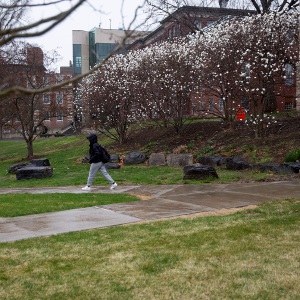Warm weather causes maple sap to flow temporarily
| Published: 01-03-2023 9:31 PM |
As the snow from last week’s storm melts and warm temperatures become Vermont’s reality, some Vermont sugarers are watching sap production begin.
Although February or March is the typical time for sugarers to collect sap and boil maple syrup, some larger producers start tapping their trees as early as mid-December to get ahead for the season.
“The reason why we start so early is … labor shortage and just the amount of miles and the amount of taps that we have to get to, it’s just time consuming,” said Evan Branon, co-owner of Branon Family Maple Orchards in Fairfield, Vt.
Branon’s operation has about 90,000 taps. He said his crew members started tapping trees in the second week of December and have already seen their trees produce sap.
Article continues after...
Yesterday's Most Read Articles
 Football helmet maker buys Lebanon’s Simbex
Football helmet maker buys Lebanon’s Simbex
 James Parker granted parole for his role in Dartmouth professors’ stabbing deaths
James Parker granted parole for his role in Dartmouth professors’ stabbing deaths
 Zantop daughter: ‘I wish James' family the best and hope that they are able to heal’
Zantop daughter: ‘I wish James' family the best and hope that they are able to heal’
 Kenyon: Dartmouth alumni join union-busting effort
Kenyon: Dartmouth alumni join union-busting effort
 Parker up for parole more than 2 decades after Dartmouth professor stabbing deaths
Parker up for parole more than 2 decades after Dartmouth professor stabbing deaths
 Through new school partnerships, CRREL seeks to educate young scientists
Through new school partnerships, CRREL seeks to educate young scientists
“Obviously, the trees are running right now, which is, you know, a little early, but it’s normal to have a small run right around this time of the year,” Branon said.
The typical sugaring season for Branon begins in mid-December and usually ends in the last week of April or the first of May. However, Branon said 2021 was a very short season, ending on April 9.
Technology is part of what allows Branon to get sap earlier in the season and continue longer, such as a closed system of tubing and a vacuum pump that helps keep the hole created in the tree stay fresh for longer because it’s difficult for bacteria and air to get in.
Instead of tapping trees, Reid Richardson, owner and operator of Richardson Farm Maple in Woodstock, said he spends December and January clearing and cutting trees to make firewood for next year’s sugaring season.
Richardson said he remembers starting the sugaring season as a child in the third week of February, when he had a break from school. Now the farm, which has just under 12,000 taps, begins tapping in the beginning of February.
With warming temperatures, however, Richardson said he might discuss whether to start tapping earlier in the season to avoid a “lost opportunity.” However, he said, at the same time, there is less sap produced earlier and it is less sweet.
Richardson said climate change is one potential reason sugarers are able to start their season in December or January.
“Here we are in 2023, and there’s just a scant amount of snow on the ground here in central Vermont. And if we had our trees tapped and our vacuum on, we’d be getting sap today for sure,” Richardson said.
Although Anson Tebbetts, state secretary of agriculture, said he hasn’t heard that any trees have been damaged because of sap runs in December or January, he said it is still “one of those unique aspects of ‘gosh, it shouldn’t be.’ It shouldn’t be running right now. We should be waiting till, you know, late February or March.”
According to Mark Isselhardt, maple specialist at the University of Vermont Extension, it’s “not unheard of” for sap production to occur in January — especially since whenever maple trees are exposed to temperatures above freezing, they are able to produce sap. However, he described the warm weather this season as “pretty prolonged.”
Isselhardt said one worry he has is that if warming temperatures continue long term, it might have an impact on the regeneration of sugar maples, since they are most successful at germination at low temperatures. He said he expects red maples to become more popular because they might be able to better handle changing temperatures than sugar maples.


